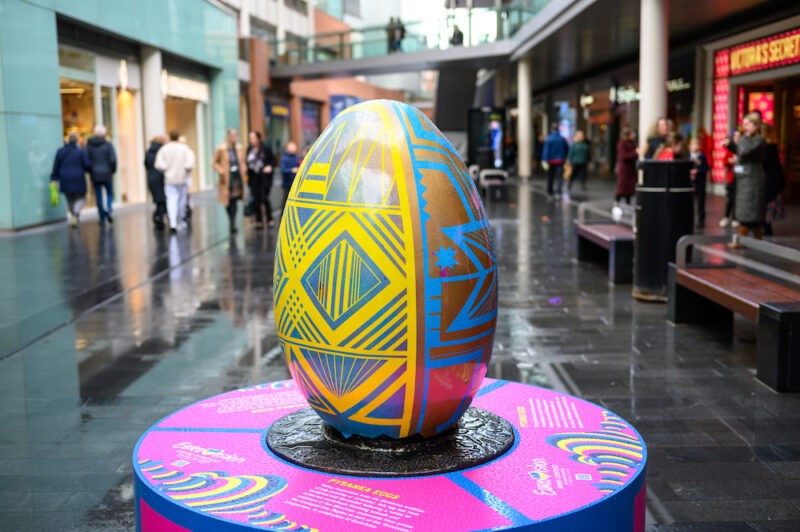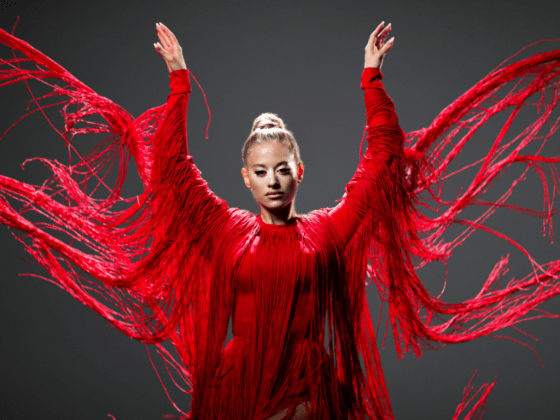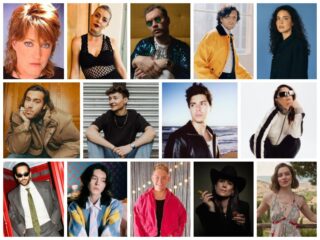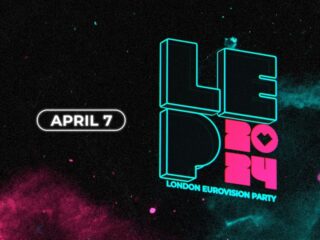Eurovision preparations are underway in Liverpool. And as the city prepares to immerse itself in song contest glory in May, a set of colourful Pysanka Eggs inspired by Ukrainian Easter traditions are now on display in the town centre.
The exhibition in shopping district Liverpool ONE features seven egg sculptures designed by children, inspired by the Eastern European tradition of egg painting. Six eggs represent the Liverpool City Region’s six districts, with one egg representing Ukraine.
The Pysanka Egg project is part of EuroLearn. It is made possible with funding from The National Lottery Heritage Fund and the Department for Culture, Media and Sport.
EuroLearn: Pysanka eggs designed by children go on display at Liverpool ONE
Six eggs represent different parts of the Liverpool City Region.
View this post on Instagram
Liverpool egg — Nadiya

The Liverpool egg, titled Nadiya, was designed by students at St Paul and St Timothy’s Catholic Infant School in West Derby and Anfield Road Primary.
Artist Amrit Singh, who painted the egg, told The Guide Liverpool: “Nadiya, which means Hope in Ukrainian, is based on the traditional art of Pysanka egg decoration, featuring vibrant colours and geometric designs. The egg’s surface is painted in shades of yellow and metallic gold, representing light, purity, and strength.
“The blue accents on the egg symbolise good health and wisdom, while the intricate patterns and texture represent growth, love, and caring. The sculpture stands tall and proud, an enduring symbol of Ukrainian heritage and tradition, exuding a sense of respect and hope.”
Knowsley egg — Singing Nightingale Watch in the Meadow

The Knowsley egg, representing the borough east of Liverpool, is titled Singing Nightingale Watch in the Meadow. It was designed by Mykhailo Pailli, a Ukrainian student at St Joseph the Worker Primary School in Kirkby.
Mykhailo’s egg depicts 37 nightingales in the flag colours of the 37 nations competing at Eurovision 2023.
Mykhailo said: “My school is a place of love and safety where I thrive”.
His mother added: “We are so proud that Mykhailo’s school was chosen to take part in the project thanks to his entry. It was very hard for him to change schools when we fled from Ukraine last April but the teachers and children have really helped him settle in.”
Artist Jo Eyles said: “The nightingale is significant because in Ukrainian culture the songbird is a creator of sweet sounds, a builder of homes and a harbinger of spring; all appropriate to represent the time of year and the theme ‘United by Music’, as well as to welcome both displaced people and a festival that was itself without a home until Liverpool adopted it”.
Sefton egg — Sounds We Love

Representing Sefton — encompassing Southport, Crosby, and Bootle — the Sounds We Love was designed by pupils at St Benedict’s Catholic Primary School.
Artist Nicola McGovern said: “The story goes that the bird came from India and sang songs to cheer people up. So, our egg explores sounds that make us feel good. This ties in really well with the themes for the EuroLearn programme of mental health and well-being, home and sanctuary.
“Pupils illustrated sounds they love from home, nature, instruments and favourite activities and these drawings have been included in the final design of the egg.”
The egg features a night-time cityscape of Liverpool and Kyiv, which celebrates the links that Eurovision 2023 has created between the two cities, and “a heartbeat, which unites us all”.
Wirral egg — Peggy

Say hello to Peggy. Designed by children at Castleway, Leasowe Primary, Eastway Primary and Hayfield Primary schools on the Wirral peninsula, this egg depicts a large feathery chicken surrounded by fauna.
Artist Pamela Sullivan said: “Every school has been incredible. The designs are beautiful and so full of love and support for the people of Ukraine but also full of hope too. Talking to the children about their designs and why they made them has been really inspiring.
“The children have shown nothing but empathy and understanding for people not just from Ukraine but from all over the world who have come to our country in desperate need of our help and support.”
St Helens egg — Vision
Students at Eccleston Lane Ends Primary School designed the Vision egg as a nod to Ukrainian and St Helens history. The stained glass design is a collaborative effort by many children, who each created a triangular piece to be applied to the egg.
Eurovision Eggs designed by children in Liverpool are unveiled at Liverpool ONE
— The Guide Liverpool ? (@TheGuideLpool) March 31, 2023
Read more ?https://t.co/YGxmFzViWx pic.twitter.com/un8tw8JixL
Artist Ruta Staseviciute said: “Glass is a massively important part of St Helens’ heritage so we chose a stained-glass design for our egg. After discussing what message we wanted to send out to Ukraine and the rest of the world, we decided on unity for the theme.
“The name is not only linked to Eurovision and stained-glass vision but also the children’s visions of love, happiness and hope.”
Ukraine egg — Peaceanka

Peaceanka is a portmanteau of peace and pysanka. This egg is a collaborative project between the Ukrainian Children’s Choir and the Association of Ukranians in Great Britain.
Father Taras Khomych, from the Association of Ukrainians in Great Britain, said: “Combining the two words, [Peaceanka] expresses the unique character of Eurovision 2023, organised by the UK on behalf of Ukraine.”
“Moreover, it captures the hopes of millions for peace in Ukraine and around the world. Easter is the celebration of new life and new hope, which are symbolically represented in our Peaceanka.”
Mykhailyma Kukharchuk, workshop coordinator, said: “Easter is a magical time in Ukraine so the children and their parents were really excited to be involved in this project.
“For families who have been displaced from their homes, getting involved in a traditional activity has helped create a sense of security and made them feel a connection with back home, reducing anxiety.”
What do you think of the Pysanka Eurovision egg displays? Will you visit this exhibition in Liverpool? Let us know in the comments.











The art ideas of the little ones are very special. The works are all very unique. Worthy of being placed where everyone can admire it
This is the first time I’ve ever seen a Wiwibloggs article with virtually no negative comments. Take it in, people.
These are fantastic, I love them!
What a wonderful project! A beautiful and unique touch. It’s very eggsciting to see all the work Liverpool are putting in as this year’s hosts.
This has to be the best build-up ever to a contest. It’s not even April yet and so much has already been done.
Lithuanians were dyeing eggs for centuries too! Back in Pagan times, it was popular among Lithuanians to bury a dyed egg in the soil as a thank you for the goddess of agriculture, Zemyna. Simultaneously, those who had livestock would put 4 eggs – 2 non-dyed and 2 dyed – on the threshold of the barn door. Once the cattle would return from grazing in the fields, it would have to walk through the threshold, crushing the eggs, both dyed and non-dyed. It was believed that this would make sure that animals would be fertile and generous whenever there were… Read more »
Catherine the horse rider? Do you mean Catherine the Great? I never heard that nickname, but I think I get what you mean ;). Considering that Ukraine used to be part of the Polish Lithuanian Commonwealth, I wouldn’t be surprised if there’s a lot of shared traditions between the countries. I actually got my first exposure to seeing these painted eggs when I saw an episode of reading rainbow on PBS. It featured children’s author, Patricia Polacco making one of these eggs because of her Russian-Ukrainian -Jewish background and that segment still sticks with me all these years. she was… Read more »
I hid a link to the video in my previous comment. Try to locate it and if check your guess was right. 🙂 As for the PLC, indeed, we were a single nation for quite some time. Even before PLC, Lithuanians and Ukrainians were united under the Grand Duchy of Lithuania. Then there was PLC, obviously, which happened to be partitioned (Lithuanians aren’t very fond of the PLC era as it reminds us of intense polonization). And even when PLC was partitioned, Lithuanians and Ukrainians (most of them) were living under the same flag. So to speak, both nations were… Read more »
Poland has this tradition too! It is called pisanka (pl. pisanki), and the technique is a bit different (they are painted in graphic patterns with wax then dyed in a specific colour, and then the wax is removed to reveal the pattern in white) but they are the same thing in principle. So, it is very likely a Ruthenian-Lithuanian-Polish tradition, likely a Christian appropriation of a local pagan ritual. (I will not comment on the Polish-Lithuanian Commonwealth much, just that I agree. Even if Ukraine got the worst of the polonisation/colonisation, Lithuania was not treated as equal either. If it… Read more »
These are all lovely. Definitely worth clicking on the links in the article for a closer inspection from different angles.
Beautiful, just in time for Easter.
Agreed, I love these! Would really like it if they made miniature versions for a little souvenir… or maybe they’ll auction them off for charity after the display ends.
Don’t forget Morris the Owl!